ABC Business Consulting: Operational Planning, Innovation, Performance
VerifiedAdded on 2022/12/20
|45
|12873
|90
Project
AI Summary
This project encompasses a comprehensive analysis of operational planning, innovation, performance management, and human resource management, drawing upon case studies of ABC Business Consulting and eCart. It begins by exploring the differences between long-term and short-term operational plans, followed by an examination of the methods used for operational planning, including goal setting, activity definition, KPI development, resource planning, communication, implementation, and evaluation. The project then delves into the role of operational plans in achieving organizational objectives, the elements of effective budgeting, and alternative approaches to developing key performance indicators. Furthermore, it addresses relevant legislation and regulations, the relevance of performance management policies, and procedures. The project also investigates innovation theories, such as Open Innovation, with practical examples. The project extends into aspects of managing people effectively, including emotional intelligence, and its impact on work health and safety. It also explores strategies for communicating with culturally diverse individuals and promoting effective workplace relationships. Finally, the project covers performance management systems, legislative requirements, and strategies for enhancing personal knowledge, skills, and work relationships. The project includes case studies, providing a practical understanding of the concepts discussed.
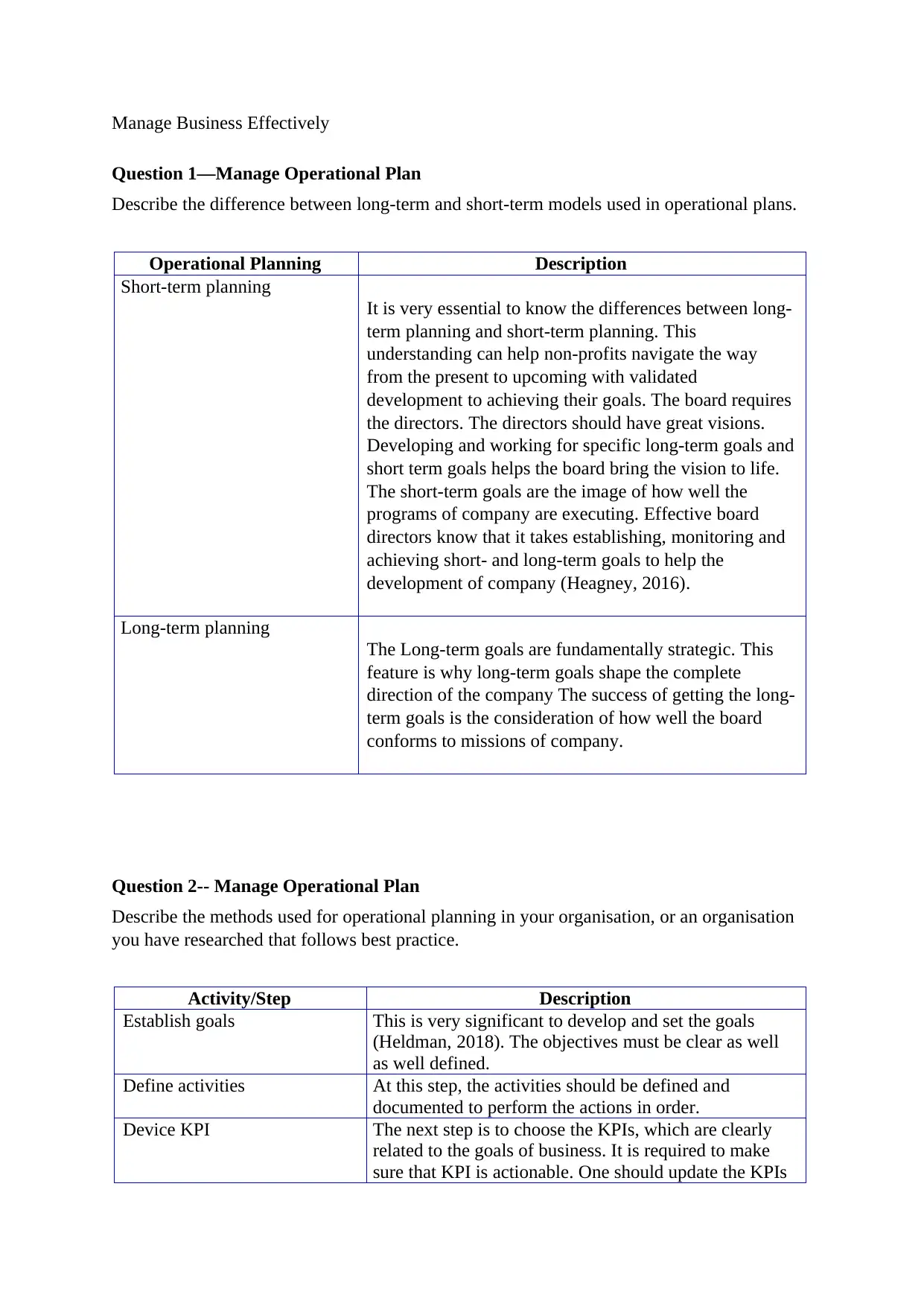
Manage Business Effectively
Question 1—Manage Operational Plan
Describe the difference between long-term and short-term models used in operational plans.
Operational Planning Description
Short-term planning
It is very essential to know the differences between long-
term planning and short-term planning. This
understanding can help non-profits navigate the way
from the present to upcoming with validated
development to achieving their goals. The board requires
the directors. The directors should have great visions.
Developing and working for specific long-term goals and
short term goals helps the board bring the vision to life.
The short-term goals are the image of how well the
programs of company are executing. Effective board
directors know that it takes establishing, monitoring and
achieving short- and long-term goals to help the
development of company (Heagney, 2016).
Long-term planning
The Long-term goals are fundamentally strategic. This
feature is why long-term goals shape the complete
direction of the company The success of getting the long-
term goals is the consideration of how well the board
conforms to missions of company.
Question 2-- Manage Operational Plan
Describe the methods used for operational planning in your organisation, or an organisation
you have researched that follows best practice.
Activity/Step Description
Establish goals This is very significant to develop and set the goals
(Heldman, 2018). The objectives must be clear as well
as well defined.
Define activities At this step, the activities should be defined and
documented to perform the actions in order.
Device KPI The next step is to choose the KPIs, which are clearly
related to the goals of business. It is required to make
sure that KPI is actionable. One should update the KPIs
Question 1—Manage Operational Plan
Describe the difference between long-term and short-term models used in operational plans.
Operational Planning Description
Short-term planning
It is very essential to know the differences between long-
term planning and short-term planning. This
understanding can help non-profits navigate the way
from the present to upcoming with validated
development to achieving their goals. The board requires
the directors. The directors should have great visions.
Developing and working for specific long-term goals and
short term goals helps the board bring the vision to life.
The short-term goals are the image of how well the
programs of company are executing. Effective board
directors know that it takes establishing, monitoring and
achieving short- and long-term goals to help the
development of company (Heagney, 2016).
Long-term planning
The Long-term goals are fundamentally strategic. This
feature is why long-term goals shape the complete
direction of the company The success of getting the long-
term goals is the consideration of how well the board
conforms to missions of company.
Question 2-- Manage Operational Plan
Describe the methods used for operational planning in your organisation, or an organisation
you have researched that follows best practice.
Activity/Step Description
Establish goals This is very significant to develop and set the goals
(Heldman, 2018). The objectives must be clear as well
as well defined.
Define activities At this step, the activities should be defined and
documented to perform the actions in order.
Device KPI The next step is to choose the KPIs, which are clearly
related to the goals of business. It is required to make
sure that KPI is actionable. One should update the KPIs
Paraphrase This Document
Need a fresh take? Get an instant paraphrase of this document with our AI Paraphraser
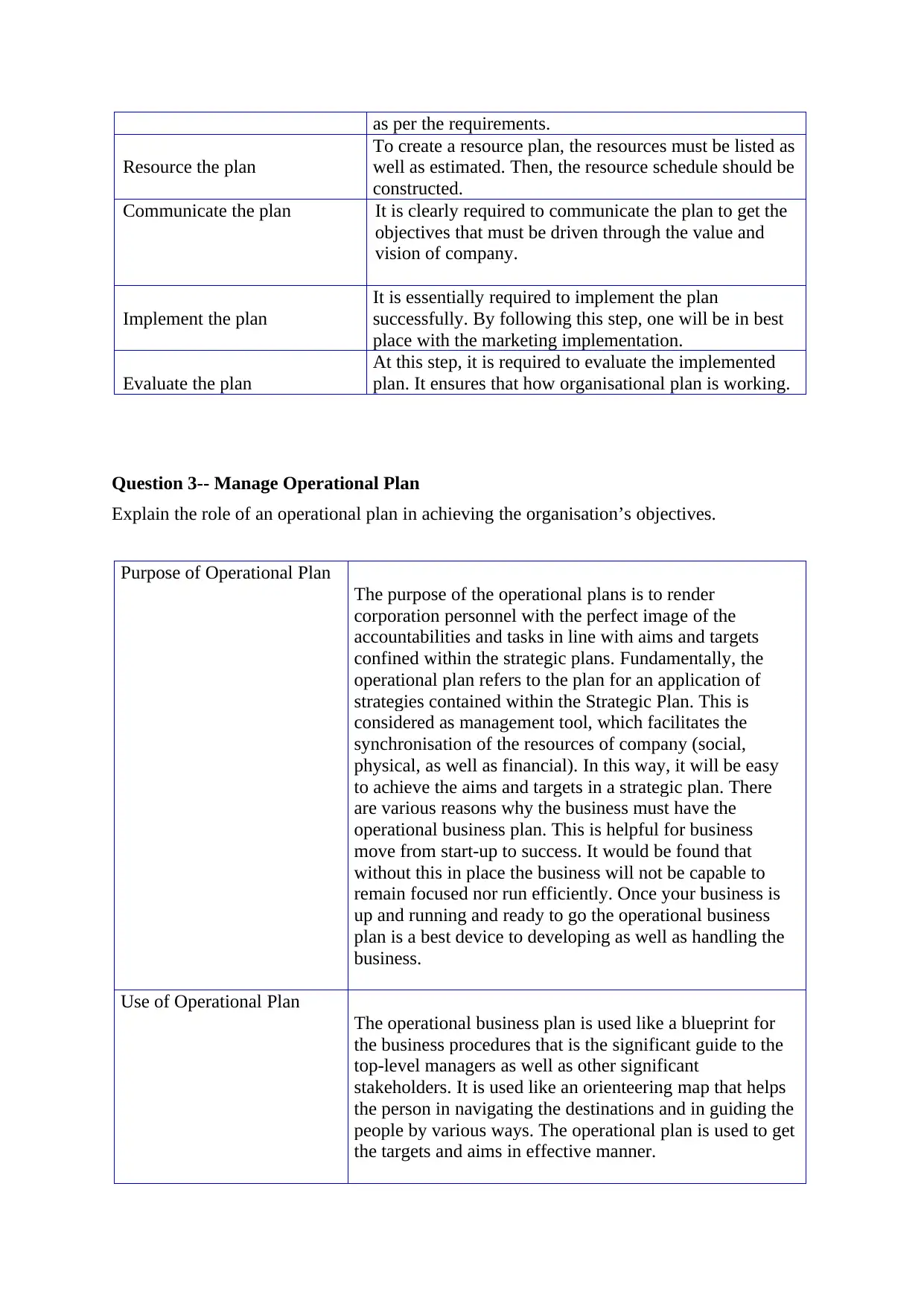
as per the requirements.
Resource the plan
To create a resource plan, the resources must be listed as
well as estimated. Then, the resource schedule should be
constructed.
Communicate the plan It is clearly required to communicate the plan to get the
objectives that must be driven through the value and
vision of company.
Implement the plan
It is essentially required to implement the plan
successfully. By following this step, one will be in best
place with the marketing implementation.
Evaluate the plan
At this step, it is required to evaluate the implemented
plan. It ensures that how organisational plan is working.
Question 3-- Manage Operational Plan
Explain the role of an operational plan in achieving the organisation’s objectives.
Purpose of Operational Plan
The purpose of the operational plans is to render
corporation personnel with the perfect image of the
accountabilities and tasks in line with aims and targets
confined within the strategic plans. Fundamentally, the
operational plan refers to the plan for an application of
strategies contained within the Strategic Plan. This is
considered as management tool, which facilitates the
synchronisation of the resources of company (social,
physical, as well as financial). In this way, it will be easy
to achieve the aims and targets in a strategic plan. There
are various reasons why the business must have the
operational business plan. This is helpful for business
move from start-up to success. It would be found that
without this in place the business will not be capable to
remain focused nor run efficiently. Once your business is
up and running and ready to go the operational business
plan is a best device to developing as well as handling the
business.
Use of Operational Plan
The operational business plan is used like a blueprint for
the business procedures that is the significant guide to the
top-level managers as well as other significant
stakeholders. It is used like an orienteering map that helps
the person in navigating the destinations and in guiding the
people by various ways. The operational plan is used to get
the targets and aims in effective manner.
Resource the plan
To create a resource plan, the resources must be listed as
well as estimated. Then, the resource schedule should be
constructed.
Communicate the plan It is clearly required to communicate the plan to get the
objectives that must be driven through the value and
vision of company.
Implement the plan
It is essentially required to implement the plan
successfully. By following this step, one will be in best
place with the marketing implementation.
Evaluate the plan
At this step, it is required to evaluate the implemented
plan. It ensures that how organisational plan is working.
Question 3-- Manage Operational Plan
Explain the role of an operational plan in achieving the organisation’s objectives.
Purpose of Operational Plan
The purpose of the operational plans is to render
corporation personnel with the perfect image of the
accountabilities and tasks in line with aims and targets
confined within the strategic plans. Fundamentally, the
operational plan refers to the plan for an application of
strategies contained within the Strategic Plan. This is
considered as management tool, which facilitates the
synchronisation of the resources of company (social,
physical, as well as financial). In this way, it will be easy
to achieve the aims and targets in a strategic plan. There
are various reasons why the business must have the
operational business plan. This is helpful for business
move from start-up to success. It would be found that
without this in place the business will not be capable to
remain focused nor run efficiently. Once your business is
up and running and ready to go the operational business
plan is a best device to developing as well as handling the
business.
Use of Operational Plan
The operational business plan is used like a blueprint for
the business procedures that is the significant guide to the
top-level managers as well as other significant
stakeholders. It is used like an orienteering map that helps
the person in navigating the destinations and in guiding the
people by various ways. The operational plan is used to get
the targets and aims in effective manner.
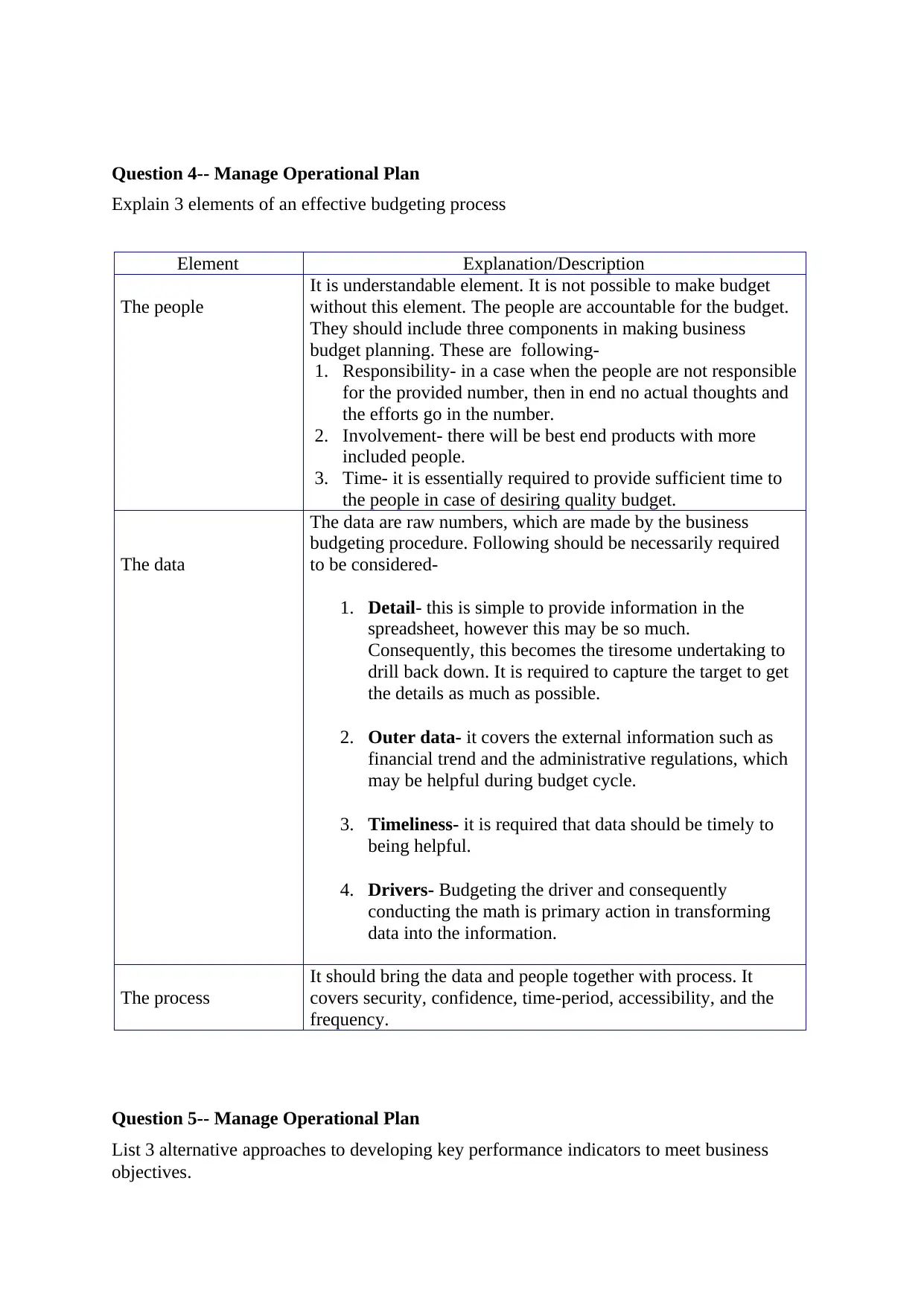
Question 4-- Manage Operational Plan
Explain 3 elements of an effective budgeting process
Element Explanation/Description
The people
It is understandable element. It is not possible to make budget
without this element. The people are accountable for the budget.
They should include three components in making business
budget planning. These are following-
1. Responsibility- in a case when the people are not responsible
for the provided number, then in end no actual thoughts and
the efforts go in the number.
2. Involvement- there will be best end products with more
included people.
3. Time- it is essentially required to provide sufficient time to
the people in case of desiring quality budget.
The data
The data are raw numbers, which are made by the business
budgeting procedure. Following should be necessarily required
to be considered-
1. Detail- this is simple to provide information in the
spreadsheet, however this may be so much.
Consequently, this becomes the tiresome undertaking to
drill back down. It is required to capture the target to get
the details as much as possible.
2. Outer data- it covers the external information such as
financial trend and the administrative regulations, which
may be helpful during budget cycle.
3. Timeliness- it is required that data should be timely to
being helpful.
4. Drivers- Budgeting the driver and consequently
conducting the math is primary action in transforming
data into the information.
The process
It should bring the data and people together with process. It
covers security, confidence, time-period, accessibility, and the
frequency.
Question 5-- Manage Operational Plan
List 3 alternative approaches to developing key performance indicators to meet business
objectives.
Explain 3 elements of an effective budgeting process
Element Explanation/Description
The people
It is understandable element. It is not possible to make budget
without this element. The people are accountable for the budget.
They should include three components in making business
budget planning. These are following-
1. Responsibility- in a case when the people are not responsible
for the provided number, then in end no actual thoughts and
the efforts go in the number.
2. Involvement- there will be best end products with more
included people.
3. Time- it is essentially required to provide sufficient time to
the people in case of desiring quality budget.
The data
The data are raw numbers, which are made by the business
budgeting procedure. Following should be necessarily required
to be considered-
1. Detail- this is simple to provide information in the
spreadsheet, however this may be so much.
Consequently, this becomes the tiresome undertaking to
drill back down. It is required to capture the target to get
the details as much as possible.
2. Outer data- it covers the external information such as
financial trend and the administrative regulations, which
may be helpful during budget cycle.
3. Timeliness- it is required that data should be timely to
being helpful.
4. Drivers- Budgeting the driver and consequently
conducting the math is primary action in transforming
data into the information.
The process
It should bring the data and people together with process. It
covers security, confidence, time-period, accessibility, and the
frequency.
Question 5-- Manage Operational Plan
List 3 alternative approaches to developing key performance indicators to meet business
objectives.
⊘ This is a preview!⊘
Do you want full access?
Subscribe today to unlock all pages.

Trusted by 1+ million students worldwide
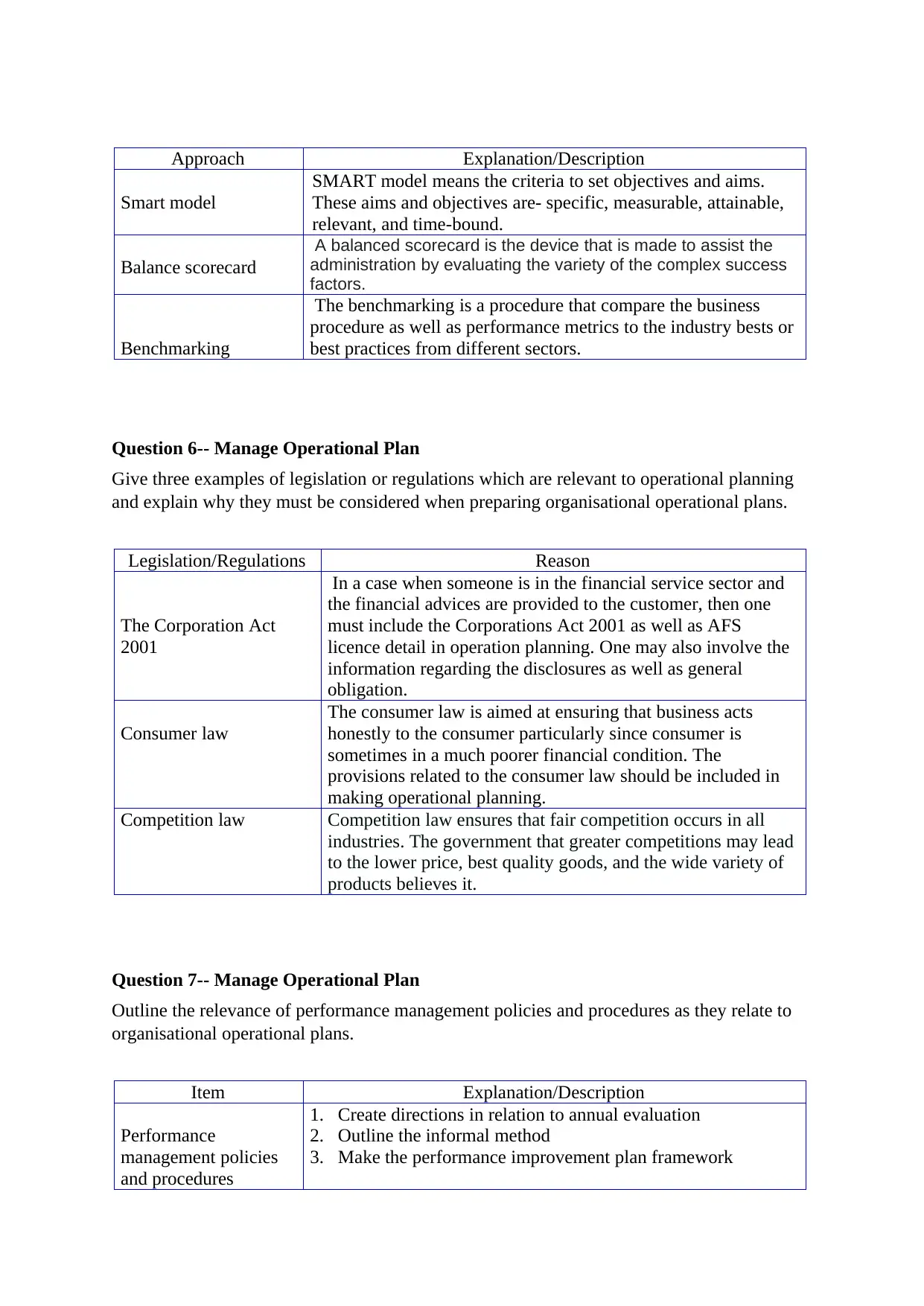
Approach Explanation/Description
Smart model
SMART model means the criteria to set objectives and aims.
These aims and objectives are- specific, measurable, attainable,
relevant, and time-bound.
Balance scorecard
A balanced scorecard is the device that is made to assist the
administration by evaluating the variety of the complex success
factors.
Benchmarking
The benchmarking is a procedure that compare the business
procedure as well as performance metrics to the industry bests or
best practices from different sectors.
Question 6-- Manage Operational Plan
Give three examples of legislation or regulations which are relevant to operational planning
and explain why they must be considered when preparing organisational operational plans.
Legislation/Regulations Reason
The Corporation Act
2001
In a case when someone is in the financial service sector and
the financial advices are provided to the customer, then one
must include the Corporations Act 2001 as well as AFS
licence detail in operation planning. One may also involve the
information regarding the disclosures as well as general
obligation.
Consumer law
The consumer law is aimed at ensuring that business acts
honestly to the consumer particularly since consumer is
sometimes in a much poorer financial condition. The
provisions related to the consumer law should be included in
making operational planning.
Competition law Competition law ensures that fair competition occurs in all
industries. The government that greater competitions may lead
to the lower price, best quality goods, and the wide variety of
products believes it.
Question 7-- Manage Operational Plan
Outline the relevance of performance management policies and procedures as they relate to
organisational operational plans.
Item Explanation/Description
Performance
management policies
and procedures
1. Create directions in relation to annual evaluation
2. Outline the informal method
3. Make the performance improvement plan framework
Smart model
SMART model means the criteria to set objectives and aims.
These aims and objectives are- specific, measurable, attainable,
relevant, and time-bound.
Balance scorecard
A balanced scorecard is the device that is made to assist the
administration by evaluating the variety of the complex success
factors.
Benchmarking
The benchmarking is a procedure that compare the business
procedure as well as performance metrics to the industry bests or
best practices from different sectors.
Question 6-- Manage Operational Plan
Give three examples of legislation or regulations which are relevant to operational planning
and explain why they must be considered when preparing organisational operational plans.
Legislation/Regulations Reason
The Corporation Act
2001
In a case when someone is in the financial service sector and
the financial advices are provided to the customer, then one
must include the Corporations Act 2001 as well as AFS
licence detail in operation planning. One may also involve the
information regarding the disclosures as well as general
obligation.
Consumer law
The consumer law is aimed at ensuring that business acts
honestly to the consumer particularly since consumer is
sometimes in a much poorer financial condition. The
provisions related to the consumer law should be included in
making operational planning.
Competition law Competition law ensures that fair competition occurs in all
industries. The government that greater competitions may lead
to the lower price, best quality goods, and the wide variety of
products believes it.
Question 7-- Manage Operational Plan
Outline the relevance of performance management policies and procedures as they relate to
organisational operational plans.
Item Explanation/Description
Performance
management policies
and procedures
1. Create directions in relation to annual evaluation
2. Outline the informal method
3. Make the performance improvement plan framework
Paraphrase This Document
Need a fresh take? Get an instant paraphrase of this document with our AI Paraphraser
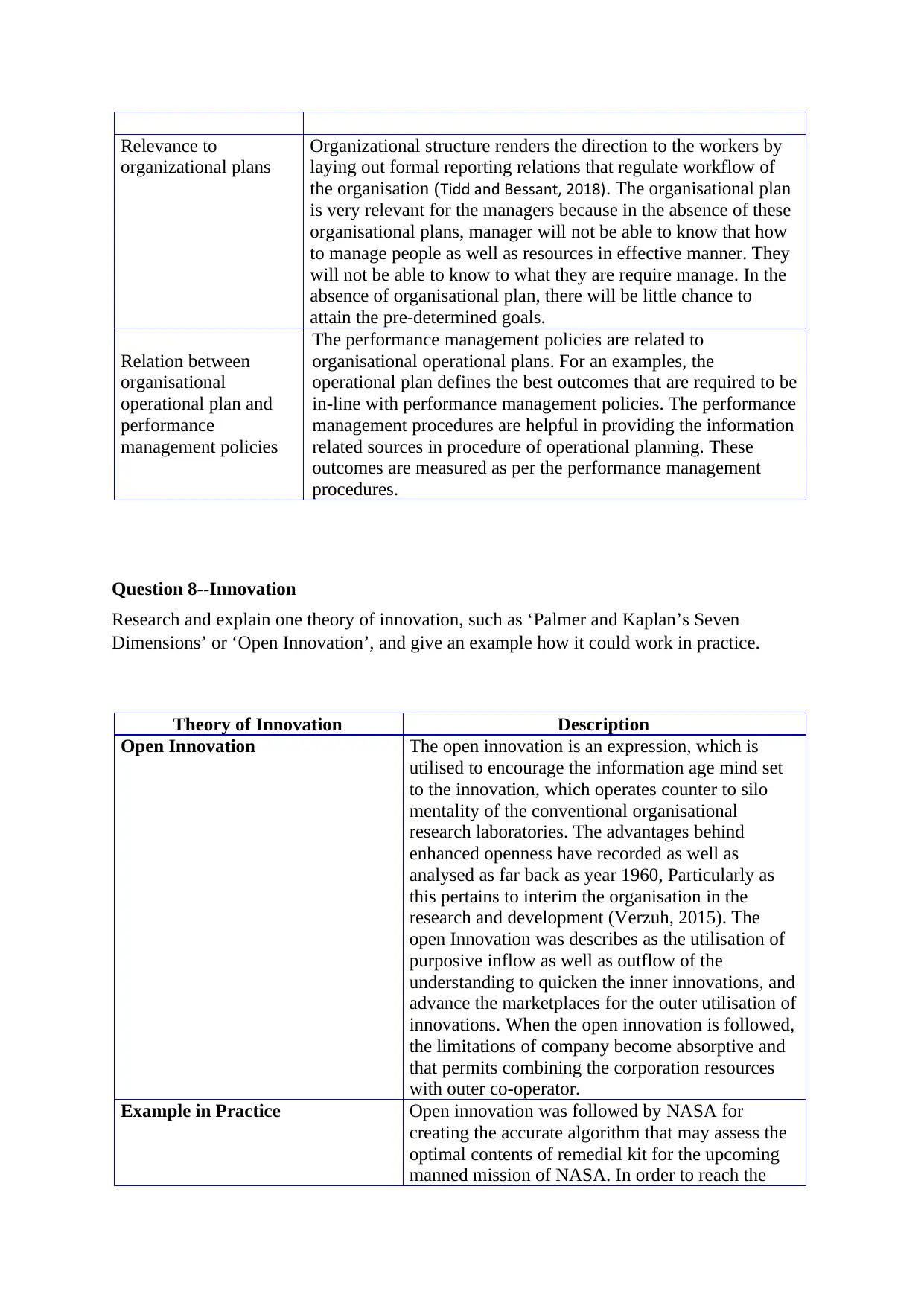
Relevance to
organizational plans
Organizational structure renders the direction to the workers by
laying out formal reporting relations that regulate workflow of
the organisation (Tidd and Bessant, 2018). The organisational plan
is very relevant for the managers because in the absence of these
organisational plans, manager will not be able to know that how
to manage people as well as resources in effective manner. They
will not be able to know to what they are require manage. In the
absence of organisational plan, there will be little chance to
attain the pre-determined goals.
Relation between
organisational
operational plan and
performance
management policies
The performance management policies are related to
organisational operational plans. For an examples, the
operational plan defines the best outcomes that are required to be
in-line with performance management policies. The performance
management procedures are helpful in providing the information
related sources in procedure of operational planning. These
outcomes are measured as per the performance management
procedures.
Question 8--Innovation
Research and explain one theory of innovation, such as ‘Palmer and Kaplan’s Seven
Dimensions’ or ‘Open Innovation’, and give an example how it could work in practice.
Theory of Innovation Description
Open Innovation The open innovation is an expression, which is
utilised to encourage the information age mind set
to the innovation, which operates counter to silo
mentality of the conventional organisational
research laboratories. The advantages behind
enhanced openness have recorded as well as
analysed as far back as year 1960, Particularly as
this pertains to interim the organisation in the
research and development (Verzuh, 2015). The
open Innovation was describes as the utilisation of
purposive inflow as well as outflow of the
understanding to quicken the inner innovations, and
advance the marketplaces for the outer utilisation of
innovations. When the open innovation is followed,
the limitations of company become absorptive and
that permits combining the corporation resources
with outer co-operator.
Example in Practice Open innovation was followed by NASA for
creating the accurate algorithm that may assess the
optimal contents of remedial kit for the upcoming
manned mission of NASA. In order to reach the
organizational plans
Organizational structure renders the direction to the workers by
laying out formal reporting relations that regulate workflow of
the organisation (Tidd and Bessant, 2018). The organisational plan
is very relevant for the managers because in the absence of these
organisational plans, manager will not be able to know that how
to manage people as well as resources in effective manner. They
will not be able to know to what they are require manage. In the
absence of organisational plan, there will be little chance to
attain the pre-determined goals.
Relation between
organisational
operational plan and
performance
management policies
The performance management policies are related to
organisational operational plans. For an examples, the
operational plan defines the best outcomes that are required to be
in-line with performance management policies. The performance
management procedures are helpful in providing the information
related sources in procedure of operational planning. These
outcomes are measured as per the performance management
procedures.
Question 8--Innovation
Research and explain one theory of innovation, such as ‘Palmer and Kaplan’s Seven
Dimensions’ or ‘Open Innovation’, and give an example how it could work in practice.
Theory of Innovation Description
Open Innovation The open innovation is an expression, which is
utilised to encourage the information age mind set
to the innovation, which operates counter to silo
mentality of the conventional organisational
research laboratories. The advantages behind
enhanced openness have recorded as well as
analysed as far back as year 1960, Particularly as
this pertains to interim the organisation in the
research and development (Verzuh, 2015). The
open Innovation was describes as the utilisation of
purposive inflow as well as outflow of the
understanding to quicken the inner innovations, and
advance the marketplaces for the outer utilisation of
innovations. When the open innovation is followed,
the limitations of company become absorptive and
that permits combining the corporation resources
with outer co-operator.
Example in Practice Open innovation was followed by NASA for
creating the accurate algorithm that may assess the
optimal contents of remedial kit for the upcoming
manned mission of NASA. In order to reach the
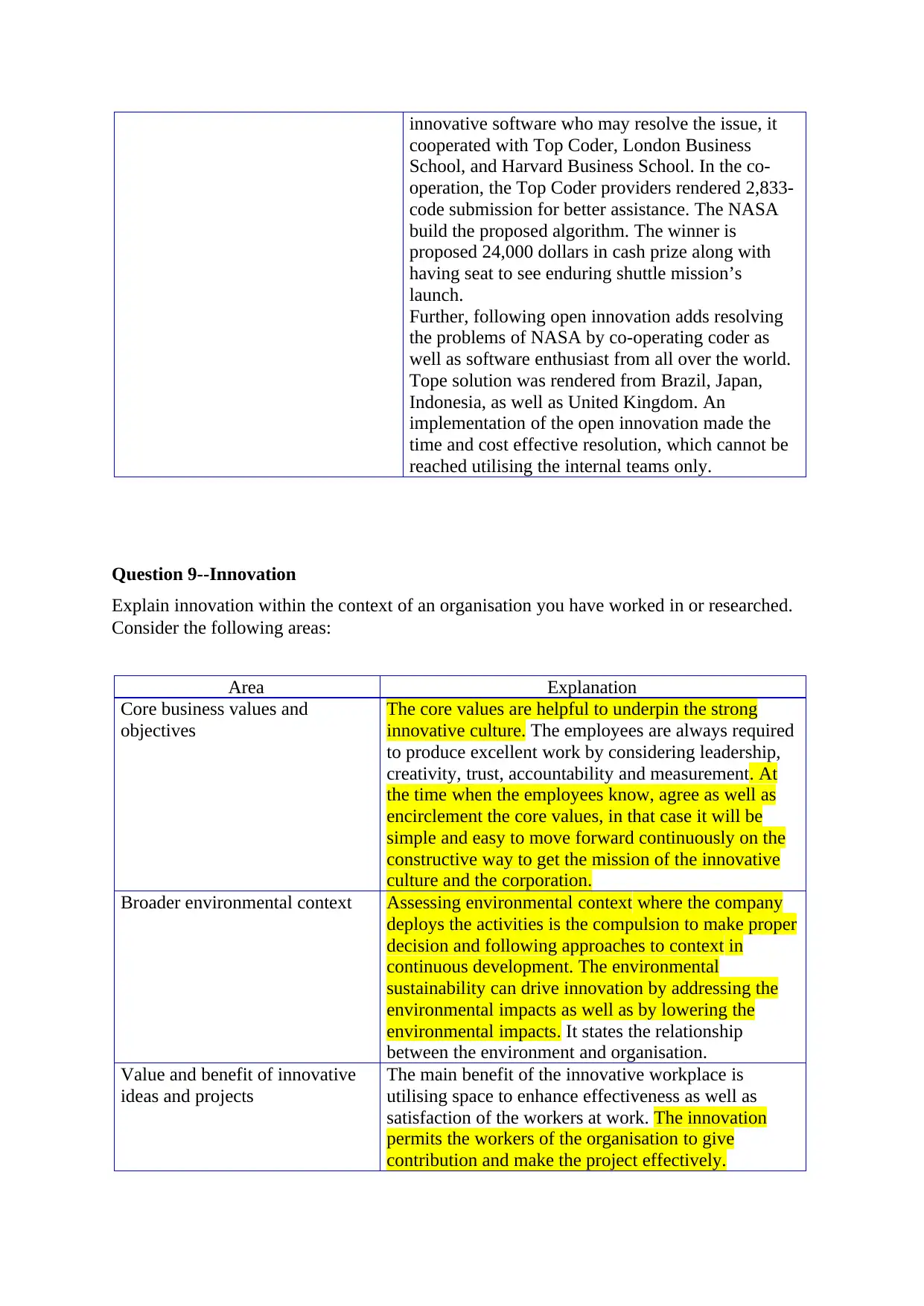
innovative software who may resolve the issue, it
cooperated with Top Coder, London Business
School, and Harvard Business School. In the co-
operation, the Top Coder providers rendered 2,833-
code submission for better assistance. The NASA
build the proposed algorithm. The winner is
proposed 24,000 dollars in cash prize along with
having seat to see enduring shuttle mission’s
launch.
Further, following open innovation adds resolving
the problems of NASA by co-operating coder as
well as software enthusiast from all over the world.
Tope solution was rendered from Brazil, Japan,
Indonesia, as well as United Kingdom. An
implementation of the open innovation made the
time and cost effective resolution, which cannot be
reached utilising the internal teams only.
Question 9--Innovation
Explain innovation within the context of an organisation you have worked in or researched.
Consider the following areas:
Area Explanation
Core business values and
objectives
The core values are helpful to underpin the strong
innovative culture. The employees are always required
to produce excellent work by considering leadership,
creativity, trust, accountability and measurement. At
the time when the employees know, agree as well as
encirclement the core values, in that case it will be
simple and easy to move forward continuously on the
constructive way to get the mission of the innovative
culture and the corporation.
Broader environmental context Assessing environmental context where the company
deploys the activities is the compulsion to make proper
decision and following approaches to context in
continuous development. The environmental
sustainability can drive innovation by addressing the
environmental impacts as well as by lowering the
environmental impacts. It states the relationship
between the environment and organisation.
Value and benefit of innovative
ideas and projects
The main benefit of the innovative workplace is
utilising space to enhance effectiveness as well as
satisfaction of the workers at work. The innovation
permits the workers of the organisation to give
contribution and make the project effectively.
cooperated with Top Coder, London Business
School, and Harvard Business School. In the co-
operation, the Top Coder providers rendered 2,833-
code submission for better assistance. The NASA
build the proposed algorithm. The winner is
proposed 24,000 dollars in cash prize along with
having seat to see enduring shuttle mission’s
launch.
Further, following open innovation adds resolving
the problems of NASA by co-operating coder as
well as software enthusiast from all over the world.
Tope solution was rendered from Brazil, Japan,
Indonesia, as well as United Kingdom. An
implementation of the open innovation made the
time and cost effective resolution, which cannot be
reached utilising the internal teams only.
Question 9--Innovation
Explain innovation within the context of an organisation you have worked in or researched.
Consider the following areas:
Area Explanation
Core business values and
objectives
The core values are helpful to underpin the strong
innovative culture. The employees are always required
to produce excellent work by considering leadership,
creativity, trust, accountability and measurement. At
the time when the employees know, agree as well as
encirclement the core values, in that case it will be
simple and easy to move forward continuously on the
constructive way to get the mission of the innovative
culture and the corporation.
Broader environmental context Assessing environmental context where the company
deploys the activities is the compulsion to make proper
decision and following approaches to context in
continuous development. The environmental
sustainability can drive innovation by addressing the
environmental impacts as well as by lowering the
environmental impacts. It states the relationship
between the environment and organisation.
Value and benefit of innovative
ideas and projects
The main benefit of the innovative workplace is
utilising space to enhance effectiveness as well as
satisfaction of the workers at work. The innovation
permits the workers of the organisation to give
contribution and make the project effectively.
⊘ This is a preview!⊘
Do you want full access?
Subscribe today to unlock all pages.

Trusted by 1+ million students worldwide
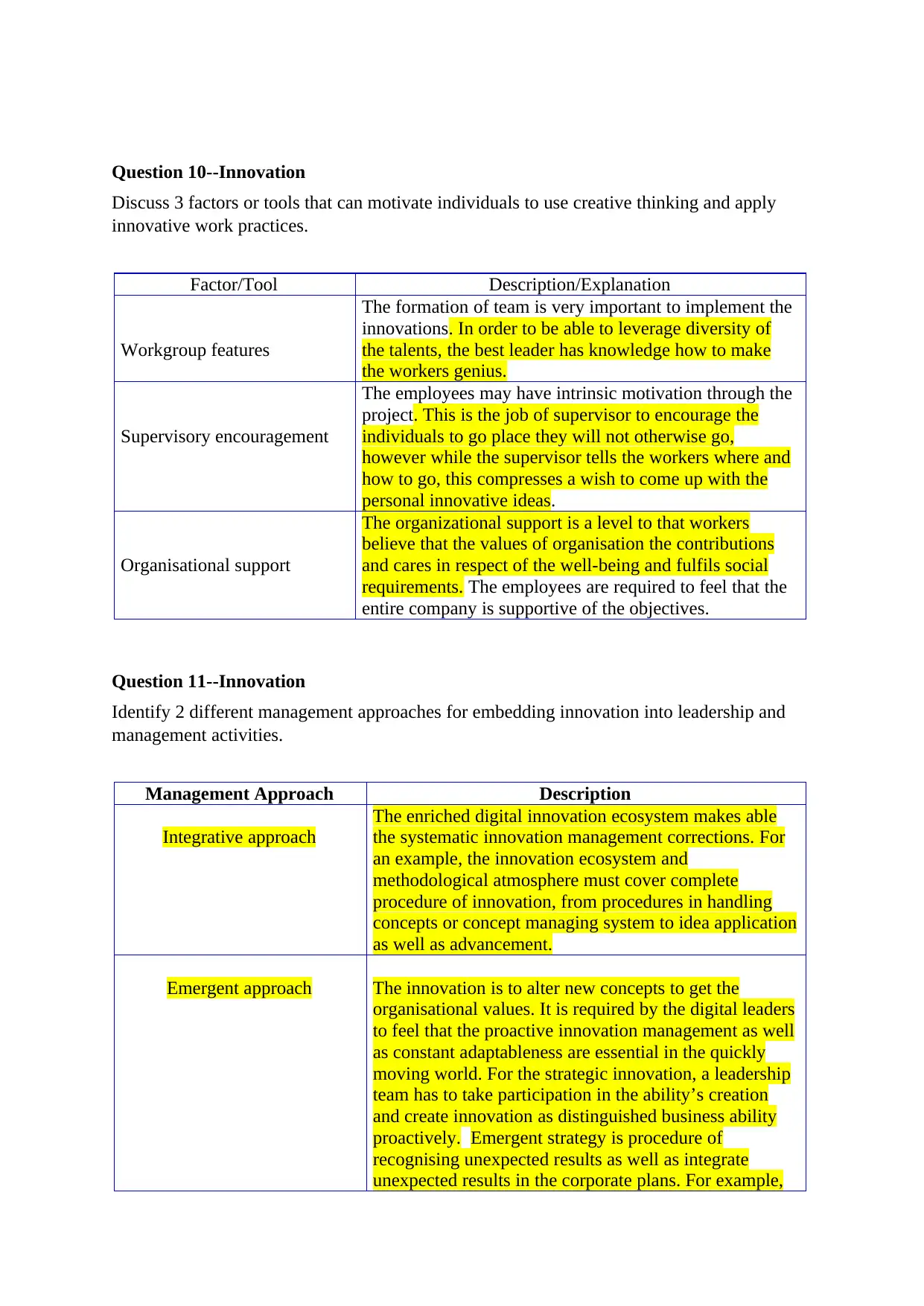
Question 10--Innovation
Discuss 3 factors or tools that can motivate individuals to use creative thinking and apply
innovative work practices.
Factor/Tool Description/Explanation
Workgroup features
The formation of team is very important to implement the
innovations. In order to be able to leverage diversity of
the talents, the best leader has knowledge how to make
the workers genius.
Supervisory encouragement
The employees may have intrinsic motivation through the
project. This is the job of supervisor to encourage the
individuals to go place they will not otherwise go,
however while the supervisor tells the workers where and
how to go, this compresses a wish to come up with the
personal innovative ideas.
Organisational support
The organizational support is a level to that workers
believe that the values of organisation the contributions
and cares in respect of the well-being and fulfils social
requirements. The employees are required to feel that the
entire company is supportive of the objectives.
Question 11--Innovation
Identify 2 different management approaches for embedding innovation into leadership and
management activities.
Management Approach Description
Integrative approach
The enriched digital innovation ecosystem makes able
the systematic innovation management corrections. For
an example, the innovation ecosystem and
methodological atmosphere must cover complete
procedure of innovation, from procedures in handling
concepts or concept managing system to idea application
as well as advancement.
Emergent approach The innovation is to alter new concepts to get the
organisational values. It is required by the digital leaders
to feel that the proactive innovation management as well
as constant adaptableness are essential in the quickly
moving world. For the strategic innovation, a leadership
team has to take participation in the ability’s creation
and create innovation as distinguished business ability
proactively. Emergent strategy is procedure of
recognising unexpected results as well as integrate
unexpected results in the corporate plans. For example,
Discuss 3 factors or tools that can motivate individuals to use creative thinking and apply
innovative work practices.
Factor/Tool Description/Explanation
Workgroup features
The formation of team is very important to implement the
innovations. In order to be able to leverage diversity of
the talents, the best leader has knowledge how to make
the workers genius.
Supervisory encouragement
The employees may have intrinsic motivation through the
project. This is the job of supervisor to encourage the
individuals to go place they will not otherwise go,
however while the supervisor tells the workers where and
how to go, this compresses a wish to come up with the
personal innovative ideas.
Organisational support
The organizational support is a level to that workers
believe that the values of organisation the contributions
and cares in respect of the well-being and fulfils social
requirements. The employees are required to feel that the
entire company is supportive of the objectives.
Question 11--Innovation
Identify 2 different management approaches for embedding innovation into leadership and
management activities.
Management Approach Description
Integrative approach
The enriched digital innovation ecosystem makes able
the systematic innovation management corrections. For
an example, the innovation ecosystem and
methodological atmosphere must cover complete
procedure of innovation, from procedures in handling
concepts or concept managing system to idea application
as well as advancement.
Emergent approach The innovation is to alter new concepts to get the
organisational values. It is required by the digital leaders
to feel that the proactive innovation management as well
as constant adaptableness are essential in the quickly
moving world. For the strategic innovation, a leadership
team has to take participation in the ability’s creation
and create innovation as distinguished business ability
proactively. Emergent strategy is procedure of
recognising unexpected results as well as integrate
unexpected results in the corporate plans. For example,
Paraphrase This Document
Need a fresh take? Get an instant paraphrase of this document with our AI Paraphraser
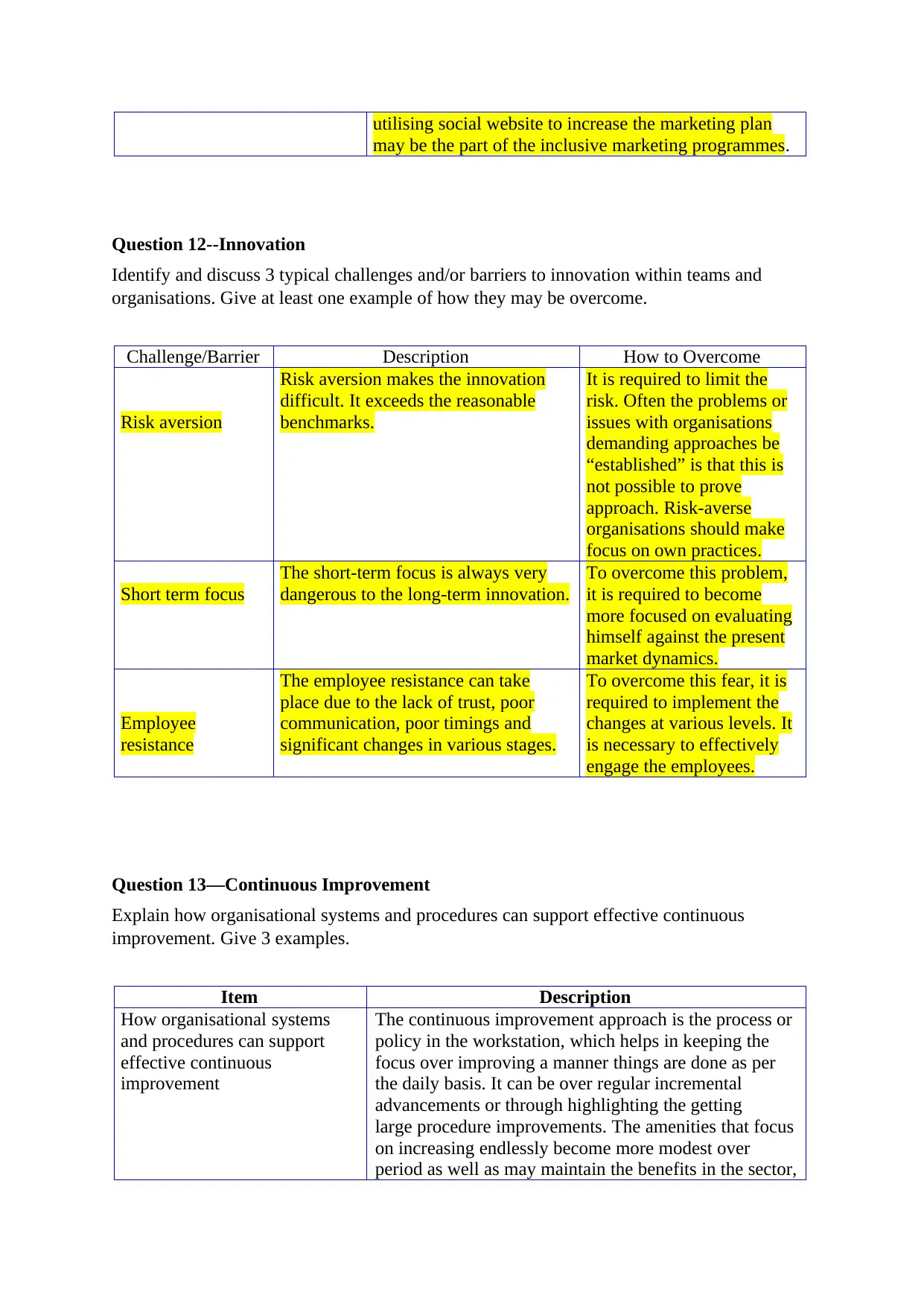
utilising social website to increase the marketing plan
may be the part of the inclusive marketing programmes.
Question 12--Innovation
Identify and discuss 3 typical challenges and/or barriers to innovation within teams and
organisations. Give at least one example of how they may be overcome.
Challenge/Barrier Description How to Overcome
Risk aversion
Risk aversion makes the innovation
difficult. It exceeds the reasonable
benchmarks.
It is required to limit the
risk. Often the problems or
issues with organisations
demanding approaches be
“established” is that this is
not possible to prove
approach. Risk-averse
organisations should make
focus on own practices.
Short term focus
The short-term focus is always very
dangerous to the long-term innovation.
To overcome this problem,
it is required to become
more focused on evaluating
himself against the present
market dynamics.
Employee
resistance
The employee resistance can take
place due to the lack of trust, poor
communication, poor timings and
significant changes in various stages.
To overcome this fear, it is
required to implement the
changes at various levels. It
is necessary to effectively
engage the employees.
Question 13—Continuous Improvement
Explain how organisational systems and procedures can support effective continuous
improvement. Give 3 examples.
Item Description
How organisational systems
and procedures can support
effective continuous
improvement
The continuous improvement approach is the process or
policy in the workstation, which helps in keeping the
focus over improving a manner things are done as per
the daily basis. It can be over regular incremental
advancements or through highlighting the getting
large procedure improvements. The amenities that focus
on increasing endlessly become more modest over
period as well as may maintain the benefits in the sector,
may be the part of the inclusive marketing programmes.
Question 12--Innovation
Identify and discuss 3 typical challenges and/or barriers to innovation within teams and
organisations. Give at least one example of how they may be overcome.
Challenge/Barrier Description How to Overcome
Risk aversion
Risk aversion makes the innovation
difficult. It exceeds the reasonable
benchmarks.
It is required to limit the
risk. Often the problems or
issues with organisations
demanding approaches be
“established” is that this is
not possible to prove
approach. Risk-averse
organisations should make
focus on own practices.
Short term focus
The short-term focus is always very
dangerous to the long-term innovation.
To overcome this problem,
it is required to become
more focused on evaluating
himself against the present
market dynamics.
Employee
resistance
The employee resistance can take
place due to the lack of trust, poor
communication, poor timings and
significant changes in various stages.
To overcome this fear, it is
required to implement the
changes at various levels. It
is necessary to effectively
engage the employees.
Question 13—Continuous Improvement
Explain how organisational systems and procedures can support effective continuous
improvement. Give 3 examples.
Item Description
How organisational systems
and procedures can support
effective continuous
improvement
The continuous improvement approach is the process or
policy in the workstation, which helps in keeping the
focus over improving a manner things are done as per
the daily basis. It can be over regular incremental
advancements or through highlighting the getting
large procedure improvements. The amenities that focus
on increasing endlessly become more modest over
period as well as may maintain the benefits in the sector,
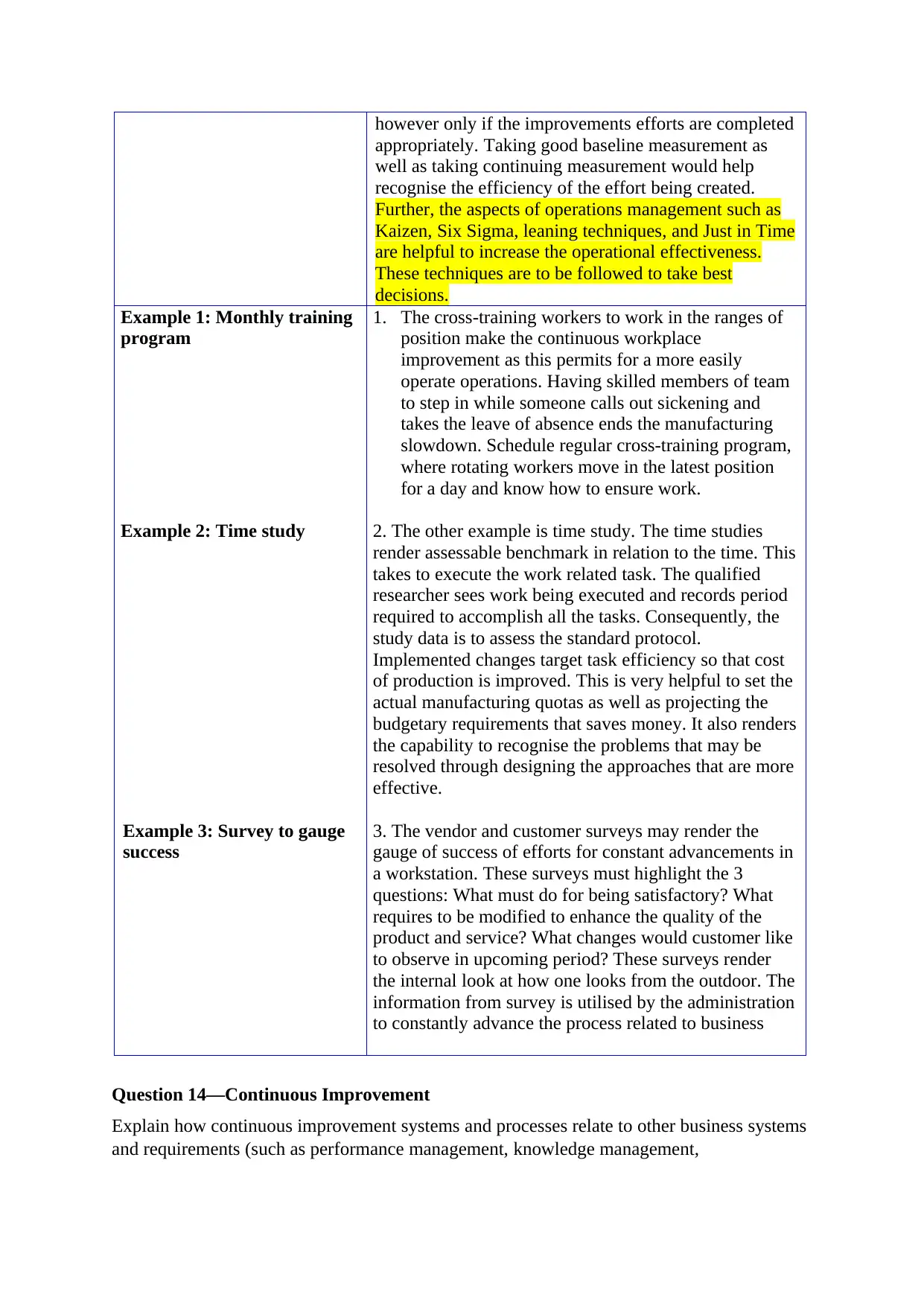
however only if the improvements efforts are completed
appropriately. Taking good baseline measurement as
well as taking continuing measurement would help
recognise the efficiency of the effort being created.
Further, the aspects of operations management such as
Kaizen, Six Sigma, leaning techniques, and Just in Time
are helpful to increase the operational effectiveness.
These techniques are to be followed to take best
decisions.
Example 1: Monthly training
program
Example 2: Time study
Example 3: Survey to gauge
success
1. The cross-training workers to work in the ranges of
position make the continuous workplace
improvement as this permits for a more easily
operate operations. Having skilled members of team
to step in while someone calls out sickening and
takes the leave of absence ends the manufacturing
slowdown. Schedule regular cross-training program,
where rotating workers move in the latest position
for a day and know how to ensure work.
2. The other example is time study. The time studies
render assessable benchmark in relation to the time. This
takes to execute the work related task. The qualified
researcher sees work being executed and records period
required to accomplish all the tasks. Consequently, the
study data is to assess the standard protocol.
Implemented changes target task efficiency so that cost
of production is improved. This is very helpful to set the
actual manufacturing quotas as well as projecting the
budgetary requirements that saves money. It also renders
the capability to recognise the problems that may be
resolved through designing the approaches that are more
effective.
3. The vendor and customer surveys may render the
gauge of success of efforts for constant advancements in
a workstation. These surveys must highlight the 3
questions: What must do for being satisfactory? What
requires to be modified to enhance the quality of the
product and service? What changes would customer like
to observe in upcoming period? These surveys render
the internal look at how one looks from the outdoor. The
information from survey is utilised by the administration
to constantly advance the process related to business
Question 14—Continuous Improvement
Explain how continuous improvement systems and processes relate to other business systems
and requirements (such as performance management, knowledge management,
appropriately. Taking good baseline measurement as
well as taking continuing measurement would help
recognise the efficiency of the effort being created.
Further, the aspects of operations management such as
Kaizen, Six Sigma, leaning techniques, and Just in Time
are helpful to increase the operational effectiveness.
These techniques are to be followed to take best
decisions.
Example 1: Monthly training
program
Example 2: Time study
Example 3: Survey to gauge
success
1. The cross-training workers to work in the ranges of
position make the continuous workplace
improvement as this permits for a more easily
operate operations. Having skilled members of team
to step in while someone calls out sickening and
takes the leave of absence ends the manufacturing
slowdown. Schedule regular cross-training program,
where rotating workers move in the latest position
for a day and know how to ensure work.
2. The other example is time study. The time studies
render assessable benchmark in relation to the time. This
takes to execute the work related task. The qualified
researcher sees work being executed and records period
required to accomplish all the tasks. Consequently, the
study data is to assess the standard protocol.
Implemented changes target task efficiency so that cost
of production is improved. This is very helpful to set the
actual manufacturing quotas as well as projecting the
budgetary requirements that saves money. It also renders
the capability to recognise the problems that may be
resolved through designing the approaches that are more
effective.
3. The vendor and customer surveys may render the
gauge of success of efforts for constant advancements in
a workstation. These surveys must highlight the 3
questions: What must do for being satisfactory? What
requires to be modified to enhance the quality of the
product and service? What changes would customer like
to observe in upcoming period? These surveys render
the internal look at how one looks from the outdoor. The
information from survey is utilised by the administration
to constantly advance the process related to business
Question 14—Continuous Improvement
Explain how continuous improvement systems and processes relate to other business systems
and requirements (such as performance management, knowledge management,
⊘ This is a preview!⊘
Do you want full access?
Subscribe today to unlock all pages.

Trusted by 1+ million students worldwide
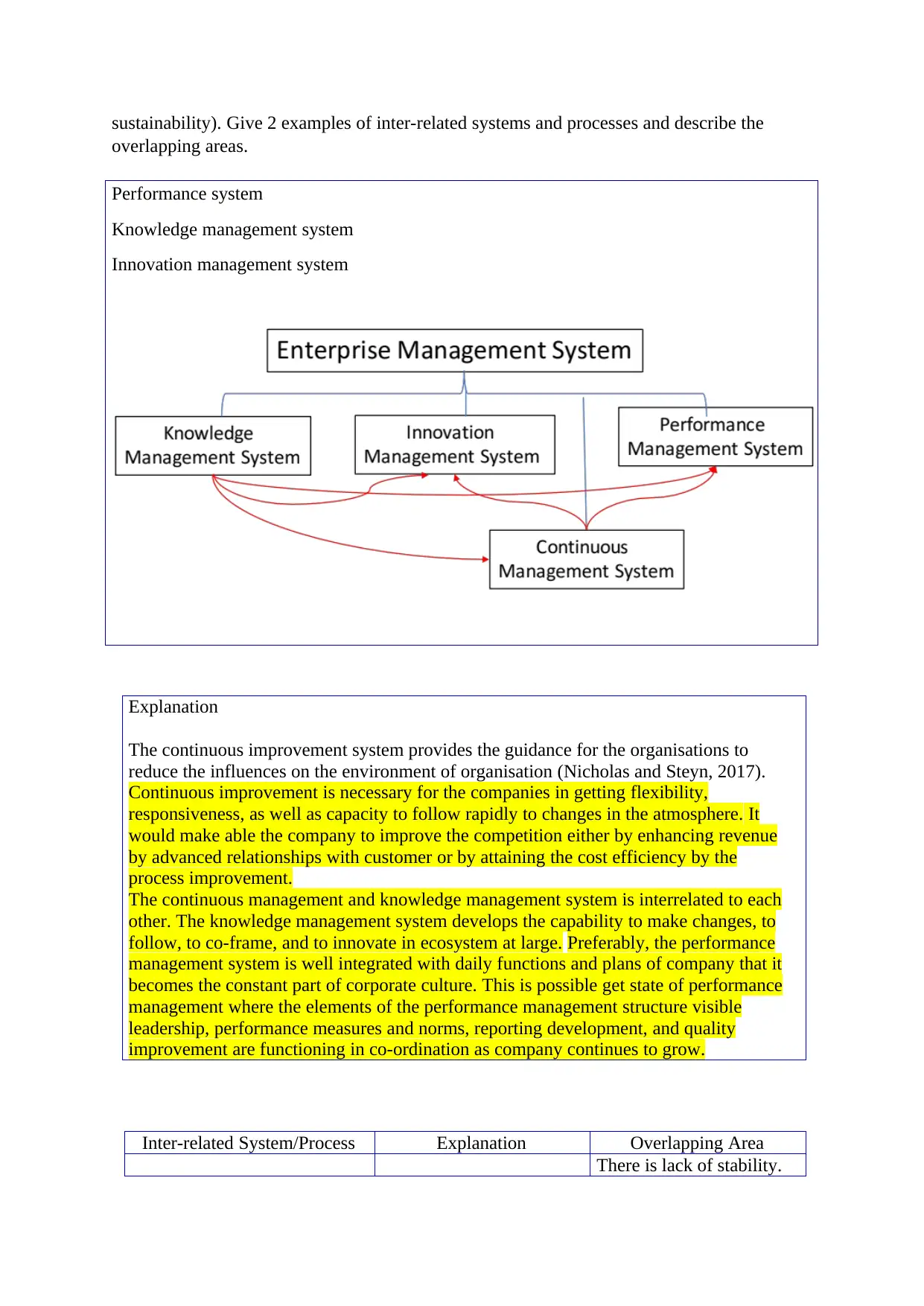
sustainability). Give 2 examples of inter-related systems and processes and describe the
overlapping areas.
Performance system
Knowledge management system
Innovation management system
Explanation
The continuous improvement system provides the guidance for the organisations to
reduce the influences on the environment of organisation (Nicholas and Steyn, 2017).
Continuous improvement is necessary for the companies in getting flexibility,
responsiveness, as well as capacity to follow rapidly to changes in the atmosphere. It
would make able the company to improve the competition either by enhancing revenue
by advanced relationships with customer or by attaining the cost efficiency by the
process improvement.
The continuous management and knowledge management system is interrelated to each
other. The knowledge management system develops the capability to make changes, to
follow, to co-frame, and to innovate in ecosystem at large. Preferably, the performance
management system is well integrated with daily functions and plans of company that it
becomes the constant part of corporate culture. This is possible get state of performance
management where the elements of the performance management structure visible
leadership, performance measures and norms, reporting development, and quality
improvement are functioning in co-ordination as company continues to grow.
Inter-related System/Process Explanation Overlapping Area
There is lack of stability.
overlapping areas.
Performance system
Knowledge management system
Innovation management system
Explanation
The continuous improvement system provides the guidance for the organisations to
reduce the influences on the environment of organisation (Nicholas and Steyn, 2017).
Continuous improvement is necessary for the companies in getting flexibility,
responsiveness, as well as capacity to follow rapidly to changes in the atmosphere. It
would make able the company to improve the competition either by enhancing revenue
by advanced relationships with customer or by attaining the cost efficiency by the
process improvement.
The continuous management and knowledge management system is interrelated to each
other. The knowledge management system develops the capability to make changes, to
follow, to co-frame, and to innovate in ecosystem at large. Preferably, the performance
management system is well integrated with daily functions and plans of company that it
becomes the constant part of corporate culture. This is possible get state of performance
management where the elements of the performance management structure visible
leadership, performance measures and norms, reporting development, and quality
improvement are functioning in co-ordination as company continues to grow.
Inter-related System/Process Explanation Overlapping Area
There is lack of stability.
Paraphrase This Document
Need a fresh take? Get an instant paraphrase of this document with our AI Paraphraser
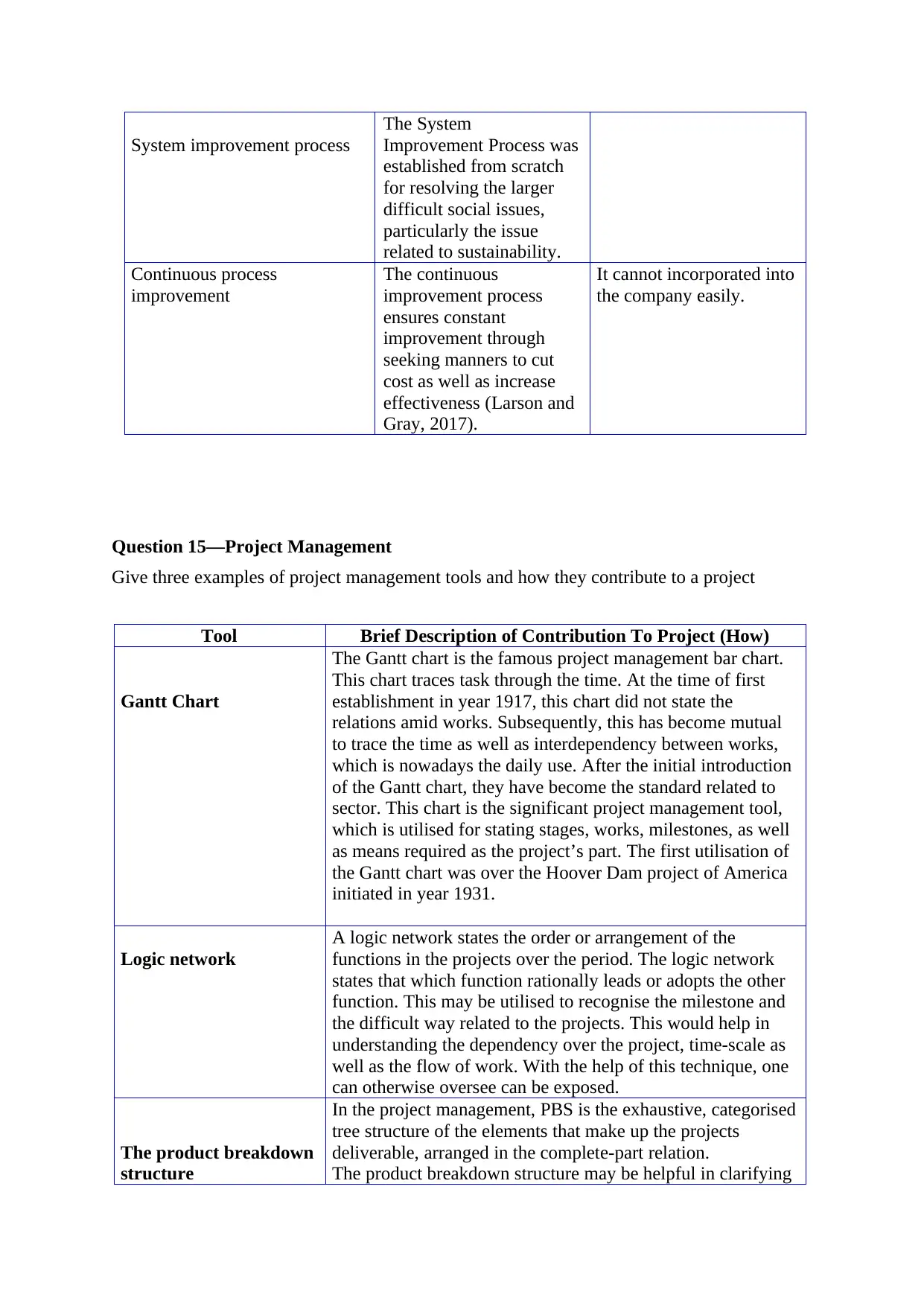
System improvement process
The System
Improvement Process was
established from scratch
for resolving the larger
difficult social issues,
particularly the issue
related to sustainability.
Continuous process
improvement
The continuous
improvement process
ensures constant
improvement through
seeking manners to cut
cost as well as increase
effectiveness (Larson and
Gray, 2017).
It cannot incorporated into
the company easily.
Question 15—Project Management
Give three examples of project management tools and how they contribute to a project
Tool Brief Description of Contribution To Project (How)
Gantt Chart
The Gantt chart is the famous project management bar chart.
This chart traces task through the time. At the time of first
establishment in year 1917, this chart did not state the
relations amid works. Subsequently, this has become mutual
to trace the time as well as interdependency between works,
which is nowadays the daily use. After the initial introduction
of the Gantt chart, they have become the standard related to
sector. This chart is the significant project management tool,
which is utilised for stating stages, works, milestones, as well
as means required as the project’s part. The first utilisation of
the Gantt chart was over the Hoover Dam project of America
initiated in year 1931.
Logic network
A logic network states the order or arrangement of the
functions in the projects over the period. The logic network
states that which function rationally leads or adopts the other
function. This may be utilised to recognise the milestone and
the difficult way related to the projects. This would help in
understanding the dependency over the project, time-scale as
well as the flow of work. With the help of this technique, one
can otherwise oversee can be exposed.
The product breakdown
structure
In the project management, PBS is the exhaustive, categorised
tree structure of the elements that make up the projects
deliverable, arranged in the complete-part relation.
The product breakdown structure may be helpful in clarifying
The System
Improvement Process was
established from scratch
for resolving the larger
difficult social issues,
particularly the issue
related to sustainability.
Continuous process
improvement
The continuous
improvement process
ensures constant
improvement through
seeking manners to cut
cost as well as increase
effectiveness (Larson and
Gray, 2017).
It cannot incorporated into
the company easily.
Question 15—Project Management
Give three examples of project management tools and how they contribute to a project
Tool Brief Description of Contribution To Project (How)
Gantt Chart
The Gantt chart is the famous project management bar chart.
This chart traces task through the time. At the time of first
establishment in year 1917, this chart did not state the
relations amid works. Subsequently, this has become mutual
to trace the time as well as interdependency between works,
which is nowadays the daily use. After the initial introduction
of the Gantt chart, they have become the standard related to
sector. This chart is the significant project management tool,
which is utilised for stating stages, works, milestones, as well
as means required as the project’s part. The first utilisation of
the Gantt chart was over the Hoover Dam project of America
initiated in year 1931.
Logic network
A logic network states the order or arrangement of the
functions in the projects over the period. The logic network
states that which function rationally leads or adopts the other
function. This may be utilised to recognise the milestone and
the difficult way related to the projects. This would help in
understanding the dependency over the project, time-scale as
well as the flow of work. With the help of this technique, one
can otherwise oversee can be exposed.
The product breakdown
structure
In the project management, PBS is the exhaustive, categorised
tree structure of the elements that make up the projects
deliverable, arranged in the complete-part relation.
The product breakdown structure may be helpful in clarifying
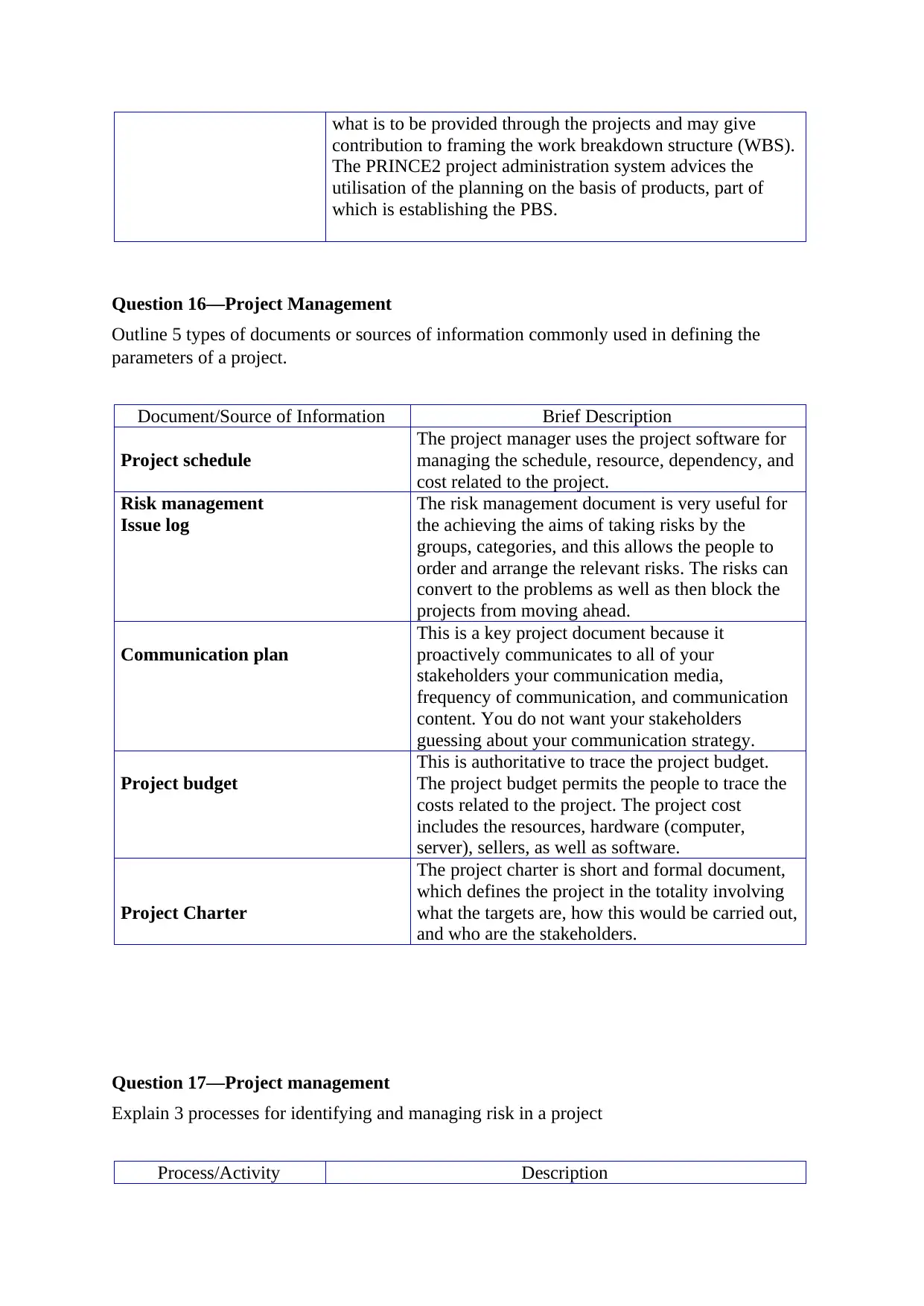
what is to be provided through the projects and may give
contribution to framing the work breakdown structure (WBS).
The PRINCE2 project administration system advices the
utilisation of the planning on the basis of products, part of
which is establishing the PBS.
Question 16—Project Management
Outline 5 types of documents or sources of information commonly used in defining the
parameters of a project.
Document/Source of Information Brief Description
Project schedule
The project manager uses the project software for
managing the schedule, resource, dependency, and
cost related to the project.
Risk management
Issue log
The risk management document is very useful for
the achieving the aims of taking risks by the
groups, categories, and this allows the people to
order and arrange the relevant risks. The risks can
convert to the problems as well as then block the
projects from moving ahead.
Communication plan
This is a key project document because it
proactively communicates to all of your
stakeholders your communication media,
frequency of communication, and communication
content. You do not want your stakeholders
guessing about your communication strategy.
Project budget
This is authoritative to trace the project budget.
The project budget permits the people to trace the
costs related to the project. The project cost
includes the resources, hardware (computer,
server), sellers, as well as software.
Project Charter
The project charter is short and formal document,
which defines the project in the totality involving
what the targets are, how this would be carried out,
and who are the stakeholders.
Question 17—Project management
Explain 3 processes for identifying and managing risk in a project
Process/Activity Description
contribution to framing the work breakdown structure (WBS).
The PRINCE2 project administration system advices the
utilisation of the planning on the basis of products, part of
which is establishing the PBS.
Question 16—Project Management
Outline 5 types of documents or sources of information commonly used in defining the
parameters of a project.
Document/Source of Information Brief Description
Project schedule
The project manager uses the project software for
managing the schedule, resource, dependency, and
cost related to the project.
Risk management
Issue log
The risk management document is very useful for
the achieving the aims of taking risks by the
groups, categories, and this allows the people to
order and arrange the relevant risks. The risks can
convert to the problems as well as then block the
projects from moving ahead.
Communication plan
This is a key project document because it
proactively communicates to all of your
stakeholders your communication media,
frequency of communication, and communication
content. You do not want your stakeholders
guessing about your communication strategy.
Project budget
This is authoritative to trace the project budget.
The project budget permits the people to trace the
costs related to the project. The project cost
includes the resources, hardware (computer,
server), sellers, as well as software.
Project Charter
The project charter is short and formal document,
which defines the project in the totality involving
what the targets are, how this would be carried out,
and who are the stakeholders.
Question 17—Project management
Explain 3 processes for identifying and managing risk in a project
Process/Activity Description
⊘ This is a preview!⊘
Do you want full access?
Subscribe today to unlock all pages.

Trusted by 1+ million students worldwide
1 out of 45
Related Documents
Your All-in-One AI-Powered Toolkit for Academic Success.
+13062052269
info@desklib.com
Available 24*7 on WhatsApp / Email
![[object Object]](/_next/static/media/star-bottom.7253800d.svg)
Unlock your academic potential
Copyright © 2020–2025 A2Z Services. All Rights Reserved. Developed and managed by ZUCOL.




